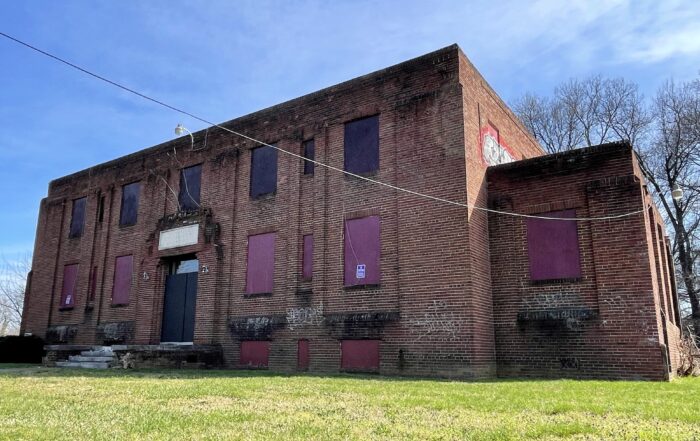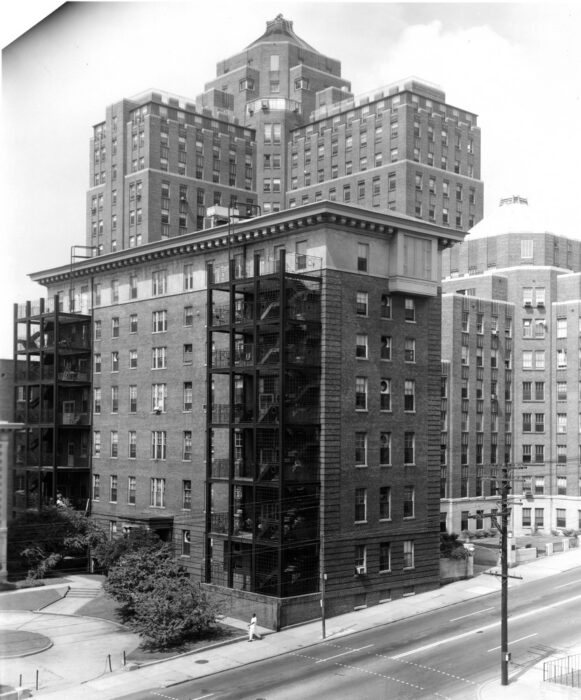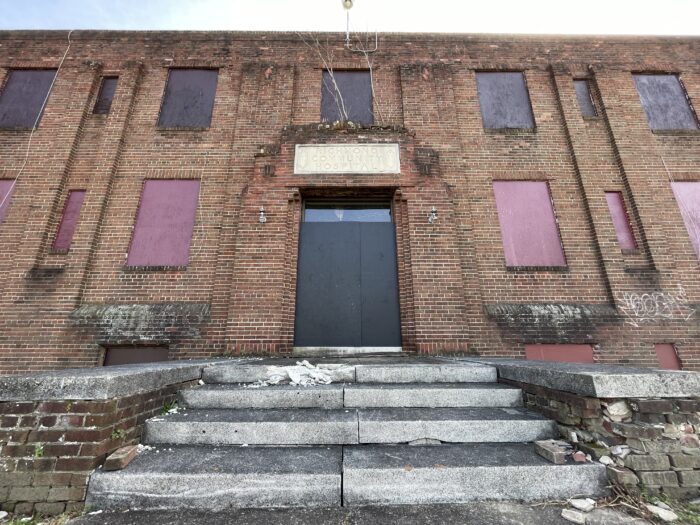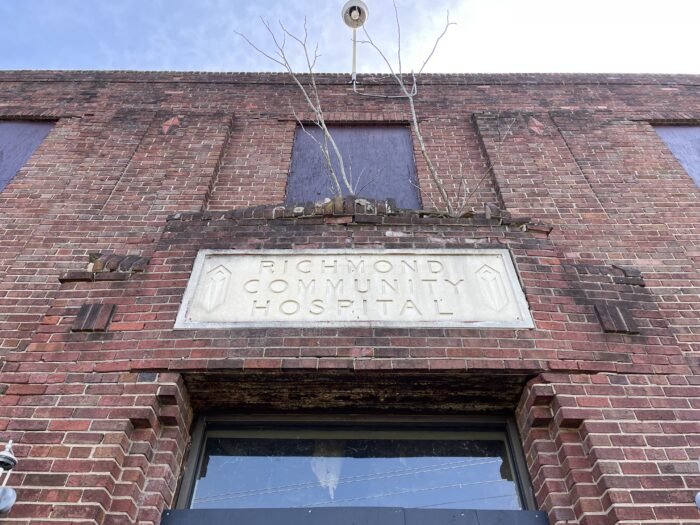
The abandoned old Richmond Community Hospital is owned by Virginia Union University. (BizSense file photo)
In Sunday night’s episode of “Abbott Elementary” on ABC-TV, the faculty and administration of the fictitious school were at odds over their building being designated a Philadelphia historic landmark. Upon researching the school’s namesake, they found that Willard R. Abbott, was no saint. The naysayers recoiled at the idea of installing an honorific plaque in the lobby.
But, hey, at least no one in Philly suggested that the schoolhouse itself be demolished.
Recently, Richmond Public Schools demolished the historically and architecturally worthy George Mason Elementary School on Church Hill at 813 N. 31st St. Its demise provided playground space for the school’s replacement, Henry L. Marsh III Elementary. An alumnus of George Mason Elementary, Marsh (1933-and retired) was a prominent civil rights lawyer, the city’s first Black mayor (elected in 1977) and a Virginia state senator. He is highly worthy of the naming honor (full disclosure: he’s a friend of mine). But did we need to lose this 100-year-plus notable African American landmark for a few plastic swing sets and slides?
A plaque or a stack of old stones or bricks, no matter how attractively configured, may attempt to memorialize a lost building, but they are no substitutes for still-standing remains of the day. When adapted to meet new and contemporary uses, fine old structures add priceless historical continuity, teach cultural and socio-economic lessons, and add rich aesthetic pleasures for young and old. Richmond is nothing if not good at the adaptive reuse of buildings.
But for a community of our size, age and aspirations, aside from many churches, Richmond has precious few historic structures that embody the African American past. Such places can be counted on a few fingers: the First Battalion Armory that houses the Black History Museum and Cultural Center of Virginia, the Winfree cottage, the Maggie L. Walker house, the former Rosa Bowser Branch of the Richmond Public Library and the Hippodrome and Bill “Bojangles” Robinson theaters.
Let’s look at some landmark losses:
The Jackson Ward offices of political firebrand John Mitchell Jr. (1863-1929) who edited the Richmond Planet newspaper for 50 years. He was also a trailblazing city council member and a gubernatorial candidate.
Great swaths of Jackson Ward and Randolph were sliced out of the cityscape with the construction of Interstates 95 and 64 and the Downtown Expressway, respectively.
The handsome former headquarters of Maggie L. Walker’s Consolidated Bank & Trust Company (designed by Black architect Charles T. Russell, 1875-1952) was torn down for a small parking lot when a new bank was completed across North Second Street at East Marshall Street.
On the downtown VCU Health campus, a lonely, salvaged stone door frame embedded in the Marshall Street sidewalk is all that’s left where adjacent, handsome hospitals once stood – the Dooley Hospital for children and St. Philip for Black adults.
Back in Jackson Ward, the former Eggleston Hotel once stood at 813 N. Second St. and hosted such luminaries as Mohammed Ali, Louis Armstrong, Duke Ellington, Billie Holiday and Martin Luther King Jr. The building’s rear partially collapsed in the spring of 2009 and could have been shored up and restored. But no. In the middle of an April Saturday night, the entire building was bulldozed.
But some positive developments are on the horizon. The City of Richmond is finally recognizing and acquiring all-but-forgotten Black cemeteries – a major preservation victory. And after years of discussion, an ambitious master plan was recently unveiled for Shockoe Valley, a fraught part of town. The area will tackle the stories and honor the memory of enslaved people who passed through there.
And more modestly at Virginia Union University, whose Northside grounds and buildings have composed our city’s piece de resistance of Black architectural history for 156 years, the long-forlorn granite-walled Industrial Hall is being restored and transformed into a university gallery museum.
But wait, there’s more. And it isn’t good.
In early February, as a back-handed slap to Black History Month no less, Virginia Union announced plans to demolish the abandoned but sturdy former Richmond Community Hospital that sits on university-owned property adjacent to the campus. It will be cleared to open up a site for 130 housing units. They will be for rent or purchase by the general public. The university is partnering with the Steinbridge Group, a New York-based investment firm that has pledged $42 million for the project. This will be the first phase of implementing a $500 million master plan that the university announced earlier in the year. “Why should we allow our students … not to become homeowners in this great city of Richmond?'” Hakim Lucas, VUU president, asked rhetorically in a Feb. 7 post by Virginia Public Media.
Say what? Within what university department can we find that program listed?
The old Richmond Community Hospital is an overlooked Art Deco gem at 1209 Overbrook Road. It was designed by Charles T. Russell, a VUU professor of the building and industrial arts as well as prominent local architect. After a major fundraising campaign, the hospital was opened in 1932 in the midst of the Great Depression. The aging facility was much later acquired by Bon Secours, which passed it to Virginia Union.
Since the university’s announcement of the project, the Richmond Free Press has become a weekly forum for pushback to the possible – and inexplicable – destruction of a fine building and major community landmark. Finding a new use should be no problem.
Wrote Grace H. Townes to the Free Press: “[The building] holds immense historical significance as a crucial landmark of African-American legacy in our city. During an era of segregation and medical mistrust, this hospital served as a beacon of trust and safety. The doctors who practiced there were not just health care providers; they were pillars of our community who looked like us, understood our needs, and provided care with compassion and understanding. … My four children were born at Richmond Community.”
The Rev. Jabriel M. Hasan of Sandston also weighed in: “For various reasons, ranging from racial injustices to intra-communal neglect and mismanagement, hardship marks the legacy of local, Black historic preservation,” he wrote. “Now that an opportunity arises to safeguard a monument to a way Black people united for community uplift, the choice becomes to tear it down, leaving only a marker in its place.”
Removing this unique and modest building would be a loss to Richmond’s physical character, history and Virginia Union’s intellectual integrity. American college campus structures and landscapes hold deep meaning not only for students but for alumni, staff, visitors and the broader community. The record of struggles and achievements are interwoven into such buildings as this. While not a part of the original VUU campus, the former hospital is now an embedded component of the academic and residential village that grew up near the intersection of Brook and Overbrook roads.

The abandoned old Richmond Community Hospital is owned by Virginia Union University. (BizSense file photo)
In Sunday night’s episode of “Abbott Elementary” on ABC-TV, the faculty and administration of the fictitious school were at odds over their building being designated a Philadelphia historic landmark. Upon researching the school’s namesake, they found that Willard R. Abbott, was no saint. The naysayers recoiled at the idea of installing an honorific plaque in the lobby.
But, hey, at least no one in Philly suggested that the schoolhouse itself be demolished.
Recently, Richmond Public Schools demolished the historically and architecturally worthy George Mason Elementary School on Church Hill at 813 N. 31st St. Its demise provided playground space for the school’s replacement, Henry L. Marsh III Elementary. An alumnus of George Mason Elementary, Marsh (1933-and retired) was a prominent civil rights lawyer, the city’s first Black mayor (elected in 1977) and a Virginia state senator. He is highly worthy of the naming honor (full disclosure: he’s a friend of mine). But did we need to lose this 100-year-plus notable African American landmark for a few plastic swing sets and slides?
A plaque or a stack of old stones or bricks, no matter how attractively configured, may attempt to memorialize a lost building, but they are no substitutes for still-standing remains of the day. When adapted to meet new and contemporary uses, fine old structures add priceless historical continuity, teach cultural and socio-economic lessons, and add rich aesthetic pleasures for young and old. Richmond is nothing if not good at the adaptive reuse of buildings.
But for a community of our size, age and aspirations, aside from many churches, Richmond has precious few historic structures that embody the African American past. Such places can be counted on a few fingers: the First Battalion Armory that houses the Black History Museum and Cultural Center of Virginia, the Winfree cottage, the Maggie L. Walker house, the former Rosa Bowser Branch of the Richmond Public Library and the Hippodrome and Bill “Bojangles” Robinson theaters.
Let’s look at some landmark losses:
The Jackson Ward offices of political firebrand John Mitchell Jr. (1863-1929) who edited the Richmond Planet newspaper for 50 years. He was also a trailblazing city council member and a gubernatorial candidate.
Great swaths of Jackson Ward and Randolph were sliced out of the cityscape with the construction of Interstates 95 and 64 and the Downtown Expressway, respectively.
The handsome former headquarters of Maggie L. Walker’s Consolidated Bank & Trust Company (designed by Black architect Charles T. Russell, 1875-1952) was torn down for a small parking lot when a new bank was completed across North Second Street at East Marshall Street.
On the downtown VCU Health campus, a lonely, salvaged stone door frame embedded in the Marshall Street sidewalk is all that’s left where adjacent, handsome hospitals once stood – the Dooley Hospital for children and St. Philip for Black adults.
Back in Jackson Ward, the former Eggleston Hotel once stood at 813 N. Second St. and hosted such luminaries as Mohammed Ali, Louis Armstrong, Duke Ellington, Billie Holiday and Martin Luther King Jr. The building’s rear partially collapsed in the spring of 2009 and could have been shored up and restored. But no. In the middle of an April Saturday night, the entire building was bulldozed.
But some positive developments are on the horizon. The City of Richmond is finally recognizing and acquiring all-but-forgotten Black cemeteries – a major preservation victory. And after years of discussion, an ambitious master plan was recently unveiled for Shockoe Valley, a fraught part of town. The area will tackle the stories and honor the memory of enslaved people who passed through there.
And more modestly at Virginia Union University, whose Northside grounds and buildings have composed our city’s piece de resistance of Black architectural history for 156 years, the long-forlorn granite-walled Industrial Hall is being restored and transformed into a university gallery museum.
But wait, there’s more. And it isn’t good.
In early February, as a back-handed slap to Black History Month no less, Virginia Union announced plans to demolish the abandoned but sturdy former Richmond Community Hospital that sits on university-owned property adjacent to the campus. It will be cleared to open up a site for 130 housing units. They will be for rent or purchase by the general public. The university is partnering with the Steinbridge Group, a New York-based investment firm that has pledged $42 million for the project. This will be the first phase of implementing a $500 million master plan that the university announced earlier in the year. “Why should we allow our students … not to become homeowners in this great city of Richmond?'” Hakim Lucas, VUU president, asked rhetorically in a Feb. 7 post by Virginia Public Media.
Say what? Within what university department can we find that program listed?
The old Richmond Community Hospital is an overlooked Art Deco gem at 1209 Overbrook Road. It was designed by Charles T. Russell, a VUU professor of the building and industrial arts as well as prominent local architect. After a major fundraising campaign, the hospital was opened in 1932 in the midst of the Great Depression. The aging facility was much later acquired by Bon Secours, which passed it to Virginia Union.
Since the university’s announcement of the project, the Richmond Free Press has become a weekly forum for pushback to the possible – and inexplicable – destruction of a fine building and major community landmark. Finding a new use should be no problem.
Wrote Grace H. Townes to the Free Press: “[The building] holds immense historical significance as a crucial landmark of African-American legacy in our city. During an era of segregation and medical mistrust, this hospital served as a beacon of trust and safety. The doctors who practiced there were not just health care providers; they were pillars of our community who looked like us, understood our needs, and provided care with compassion and understanding. … My four children were born at Richmond Community.”
The Rev. Jabriel M. Hasan of Sandston also weighed in: “For various reasons, ranging from racial injustices to intra-communal neglect and mismanagement, hardship marks the legacy of local, Black historic preservation,” he wrote. “Now that an opportunity arises to safeguard a monument to a way Black people united for community uplift, the choice becomes to tear it down, leaving only a marker in its place.”
Removing this unique and modest building would be a loss to Richmond’s physical character, history and Virginia Union’s intellectual integrity. American college campus structures and landscapes hold deep meaning not only for students but for alumni, staff, visitors and the broader community. The record of struggles and achievements are interwoven into such buildings as this. While not a part of the original VUU campus, the former hospital is now an embedded component of the academic and residential village that grew up near the intersection of Brook and Overbrook roads.






Hope this hospital and other historic landmarks can be saved. Of course, a lot of Richmonders overlook the small places that families lived in like the historic John Miller House. “John Miller, a free black cooper and minister, built this house about 1858. It is significant as a rare surviving antebellum house in Richmond constructed by and for a free African American family. More than two thousand free blacks lived in Richmond at the time of the Civil War; at least two hundred of them were homeowners. Miller was an influential member of the small free black community that existed… Read more »
This building has been setting vacant for decades and now that Virginia Union a black run organization wants to tear it down and improve the area people are up in arms. It would be extremely expensive to renovate this building after the all but certain years of water getting into the building but it is easy to spend other people’s money.
Just like the brain trust in Richmond let the Maggie Walker High School building fall into considerable disrepair so the budget for its renovation would have to balloon astronomically.
“The City of Richmond is finally recognizing and acquiring all-but-forgotten Black cemeteries – a major preservation victory.”
Conversely, Shockoe Hill Cemetery is routinely neglected by the city and would be in worse shape if not for the efforts of The Friends of Shockoe Hill Cemetery.
What di you except from leadership that is all talk. They never walk the walk (or do a cleanup either unless photographers are around).
The building was given to VUU by the Board of Richmond Community Hospital before Bon Secour acquired Richmond Community Hospital. Another mis-conception of Black History in Richmond.
Tear it down,who cares.
Great job on this article Mr. Slipek. It always amazes me when people get in an uproar over a building that is destined for demolition. Where were those civic minded and concerned people several years ago? Were they fundraising to purchase and repurpose this historical Richmond landmark? Yes, I do believe in preservation and repurposing this landmark, dont get the wrong idea. I may be wrong, but did VUU make a quick turnaround and now sees the value of preserving this building because of the numerous public outcries? Hmmmmm, it has to make one wonder, at least I do. Yes,… Read more »
Sometimes, for certain people who like to control rather than build, it matter more WHO is destroying what has been abandoned to build something new.
Well written article on a potential loss for Richmond.
One of the several reasons Philly has suffered for many decades was folks preventing redevelopment. The result was often, eventually, very historic places becoming derilict and eventual crumbling into ruin.
I suggest people who want to preserve, pool resources to make a positive change! Monies talk and people listen when monies are on the table. Those folks that stand in the way “can be removed” with a solid plan and people that are committed.
One of the things that I have most enjoyed about Richmond BizSense over the years is the absence of (author-) opinionated and interpretive articles published, generally speaking. I understand this piece was labeled “Guest Commentary”, however I personally feel that this genre of reporting should be published elsewhere. I believe most would agree that Op/Ed reporting can be found (ad nauseum) just about everywhere in media, although often disguised as objective reporting. RBS should remain as objective as possible and refrain from this type of biased and opinionated journalism. Leave the interpretive conversation and commentary to the readers of the… Read more »